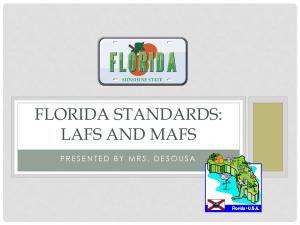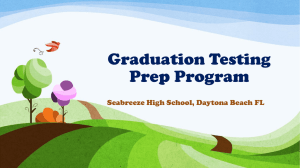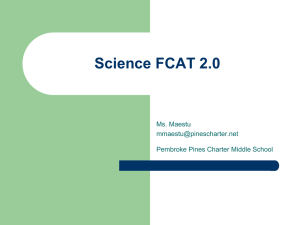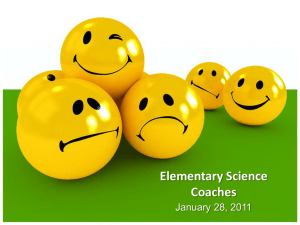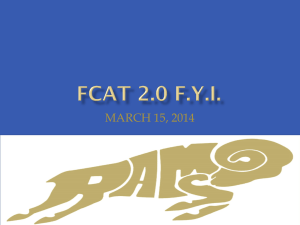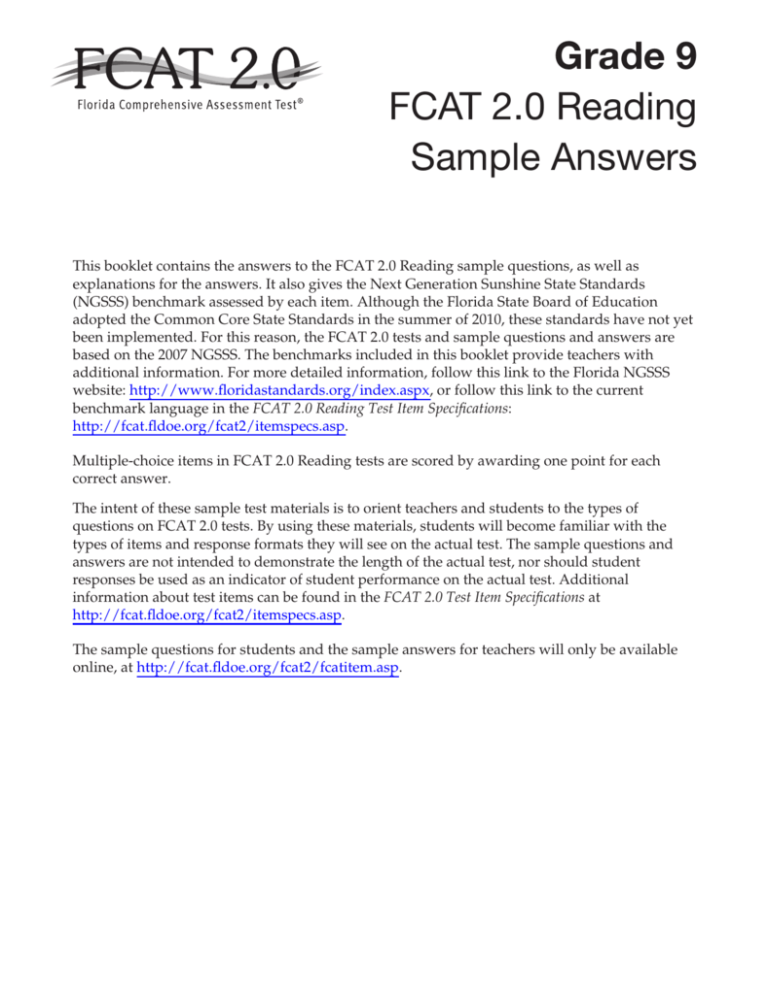
Grade 9
FCAT 2.0 Reading
Sample Answers
This booklet contains the answers to the FCAT 2.0 Reading sample questions, as well as
explanations for the answers. It also gives the Next Generation Sunshine State Standards
(NGSSS) benchmark assessed by each item. Although the Florida State Board of Education
adopted the Common Core State Standards in the summer of 2010, these standards have not yet
been implemented. For this reason, the FCAT 2.0 tests and sample questions and answers are
based on the 2007 NGSSS. The benchmarks included in this booklet provide teachers with
additional information. For more detailed information, follow this link to the Florida NGSSS
website: http://www.floridastandards.org/index.aspx, or follow this link to the current
benchmark language in the FCAT 2.0 Reading Test Item Specifications:
http://fcat.fldoe.org/fcat2/itemspecs.asp.
Multiple-choice items in FCAT 2.0 Reading tests are scored by awarding one point for each
correct answer.
The intent of these sample test materials is to orient teachers and students to the types of
questions on FCAT 2.0 tests. By using these materials, students will become familiar with the
types of items and response formats they will see on the actual test. The sample questions and
answers are not intended to demonstrate the length of the actual test, nor should student
responses be used as an indicator of student performance on the actual test. Additional
information about test items can be found in the FCAT 2.0 Test Item Specifications at
http://fcat.fldoe.org/fcat2/itemspecs.asp.
The sample questions for students and the sample answers for teachers will only be available
online, at http://fcat.fldoe.org/fcat2/fcatitem.asp.
SAMPLE
9
FCAT 2.0 Reading Sample Answers
Article: “The Night Hunters”
“The Night Hunters” by Robert W. Criswell, reprinted by permission of the author. All rights reserved.
1
The correct answer is B (arouse readers’ interest in a unique group of birds).
Type of Text: Informational
Benchmark: LA.910.1.7.2
The student will analyze the author’s purpose and/or
perspective in a variety of text and understand how they affect meaning.
The correct answer is B. The author uses words and phrases such as amazing, “Tiger of the
Skies,” night hunters par excellence, and can catch a mouse on a barn floor in total darkness to
capture readers’ interest in owls.
2
The correct answer is I (alliteration, repeating a sound to emphasize the
superiority of owls).
Type of Text: Informational
Benchmark: LA.910.2.1.7
The student will analyze, interpret, and evaluate an
author’s use of descriptive language (e.g., tone, irony, mood, imagery, pun,
alliteration, onomatopoeia, allusion), figurative language (e.g., symbolism,
metaphor, personification, hyperbole), common idioms, and mythological and
literary allusions, and explain how they impact meaning in a variety of texts.
The correct answer is I. The author uses alliteration in these sentences. The repetition of
the initial consonant sound p in the words Predators, peer, prowess, and predator
emphasizes the superiority of owls.
Page 2
FCAT 2.0 Reading Sample Answers
Florida Department of Education
SAMPLE
FCAT 2.0 Reading Sample Answers
3
9
The correct answer is A (frequent head movement).
Type of Text: Informational
Benchmark: LA.910.1.7.4
in text.
The student will identify cause-and-effect relationships
The correct answer is A. Due to the fact that owls’ eyes are extremely large and cannot
move, an owl must frequently move its head in order to change its scope of vision.
4
The correct answer is G (colors of a species).
Type of Text: Informational
Benchmark: LA.910.1.7.3
The student will determine the main idea or essential
message in grade-level or higher texts through inferring, paraphrasing,
summarizing, and identifying relevant details.
The correct answer is G. Dichromatism is a phenomenon that occurs among screech owls
and involves birds having two distinct color phases (red and gray). According to the
article, this trait is exhibited regardless of sex or age.
Page 3
FCAT 2.0 Reading Sample Answers
Florida Department of Education
SAMPLE
5
9
FCAT 2.0 Reading Sample Answers
The correct answer is A (barn owl).
Type of Text: Informational
Benchmark: LA.910.1.7.4
in text.
The student will identify cause-and-effect relationships
The correct answer is A. According to the author, barn owls typically seek grasslands
and farmlands plentiful with rodents as their habitat. Adult barn owls consume rodents
at the rate of one every four minutes and dine on a menu consisting almost exclusively of voles,
shrews, mice, and rats, all of which are rodents. The other types of owls mentioned either
do not eat rodents exclusively, or in the case of the barred owl, no mention of what it eats
was given. Therefore, based on information found in the article, a decline in the rodent
population would most affect the barn owl.
6
The correct answer is I (They find nesting places rather than construct them).
Type of Text: Informational
Benchmark: LA.910.6.2.2
The student will organize, synthesize, analyze, and
evaluate the validity and reliability of information from multiple sources
(including primary and secondary sources) to draw conclusions using a variety of
techniques, and correctly use standardized citations.
The correct answer is I. According to the article, great horned owls make use of the nests
of raptors, crows, herons, and . . . eagles. Screech owls use nests excavated by woodpeckers and
sometimes take advantage of artificial boxes. Barred owls are cavity nesters, and barn owls
nest in man-made structures. Based on this information, all the owls described in the article
find nesting places rather than make their own.
Page 4
FCAT 2.0 Reading Sample Answers
Florida Department of Education
SAMPLE
FCAT 2.0 Reading Sample Answers
7
9
The correct answer is B (its ability to mimic the calls of other species).
Type of Text: Informational
Benchmark: LA.910.1.7.4
in text.
The student will identify cause-and-effect relationships
The correct answer is B. In the first section of the article, the author makes reference to
the silent flight of owls, their keen sense of hearing, and their acute vision in dim light as
factors contributing to the owl’s effectiveness as a predator. However, the author makes
no reference to imitating the calls of other species as contributing to their effectiveness in
hunting and capturing prey.
8
The correct answer is F (the screech owl’s, because its call rarely approximates
a screech).
Type of Text: Informational
Benchmark: LA.910.6.2.2
The student will organize, synthesize, analyze, and
evaluate the validity and reliability of information from multiple sources
(including primary and secondary sources) to draw conclusions using a variety of
techniques, and correctly use standardized citations.
The correct answer is F. The screech owl’s name is most misleading. According to the
author, the bird practically never utters a sound that can be described as a “screech.” In
addition, ornithologist Roger Tory Peterson’s description of the screech owl’s call, “a
mournful whinny, or wail,” provides evidence of this bird’s misleading name.
Page 5
FCAT 2.0 Reading Sample Answers
Florida Department of Education
SAMPLE
9
9
FCAT 2.0 Reading Sample Answers
The correct answer is C (general information followed by facts specific to
each species).
Type of Text: Informational
Benchmark: LA.910.1.7.5
The student will analyze a variety of text structures
(e.g., comparison/contrast, cause/effect, chronological order, argument/support,
lists) and text features (main headings with subheadings) and explain their impact
on meaning in text.
The correct answer is C. The author begins the article by providing the reader with
general background information pertaining to owls. The author then divides the article
into five sections, each devoted to a particular species of owl. In each section, the author
gives facts and details unique to a particular species. Information was not presented
chronologically or in order of importance. Also, many features of the owls were
explained, not just their nesting habits.
10
The correct answer is I (screech owl and great horned owl).
Type of Text: Informational
Benchmark: LA.910.1.7.7
multiple texts.
The student will compare and contrast elements in
The correct answer is I. The article states that at 7–10 inches, the screech owl is the smallest of
Pennsylvania’s resident owls. The article also states that at 18–25 inches in height and up to
three pounds, it [the great horned owl] is our largest owl. The size ranges for the screech
owl and the great horned owl do not overlap, and the difference between the two ranges
is far greater than the differences in size of the other pairs of owls listed in the options.
For two of the incorrect options, the size ranges given in the article overlap. The sizes
provided for the screech owl and long-eared owl do not overlap, but they are relatively
closer in size. The smallest size given is for the screech owl, and the largest size given is
for the great horned owl.
Page 6
FCAT 2.0 Reading Sample Answers
Florida Department of Education
SAMPLE
FCAT 2.0 Reading Sample Answers
9
Article: “American Odyssey”
“American Odyssey” by Dayton R. Duncan, reprinted by permission of the author. All rights reserved. Photograph: “EXPLORERS WITH NATIVE AMERICAN
GUIDE” Copyright © North Wind Picture Archives/Alamy. Map: Reprinted courtesy of the NOAA. All rights reserved.
11
The correct answer is D (reflect on the experiences he had while retracing Lewis
and Clark’s route).
Type of Text: Informational
Benchmark: LA.910.1.7.2
The student will analyze the author’s purpose and/or
perspective in a variety of text and understand how they affect meaning.
The correct answer is D. In the article, the author’s purpose in describing his own trip
was most likely to reflect on the experiences he had while retracing the journey taken by
Lewis and Clark 200 years earlier. The author does describe how travel has changed
since the time of Lewis and Clark; however, this is only a supporting detail, and his
purpose for describing his trip was not to illustrate a transformation. The author does not
indicate that Lewis and Clark’s legacy is in question; therefore, it is unlikely that his
purpose was to verify Lewis and Clark’s legacy. Similarly, the author does not indicate
that his intention was to support the information documented in Lewis and Clark’s
journals. The author only references the journals in order to shed light on his own
discoveries while retracing Lewis and Clark’s route.
Page 7
FCAT 2.0 Reading Sample Answers
Florida Department of Education
SAMPLE
12
9
FCAT 2.0 Reading Sample Answers
The correct answer is I (progressing an average of twelve miles per day).
Type of Text: Informational
Benchmark: LA.910.1.7.3
The student will determine the main idea or essential
message in grade-level or higher texts through inferring, paraphrasing,
summarizing, and identifying relevant details.
The correct answer is I. According to the author, they understood––as no other Americans at
the time could––just how big, how rugged, how mind-bogglingly varied this country really is.
They understood because they had crossed it at a pace of 12 miles a day.
13
The correct answer is C (Only land travel offers genuine understanding of scale).
Type of Text: Informational
Benchmark: LA.910.1.6.8
The student will identify advanced word/phrase
relationships and their meanings.
The correct answer is C. Based on the sentence provided, the author presents his view
that the only means of comprehending the vastness of the country is to travel by land in
all those seemingly endless, open, empty spaces. Option C clearly restates or reinforces this
idea.
Page 8
FCAT 2.0 Reading Sample Answers
Florida Department of Education
SAMPLE
FCAT 2.0 Reading Sample Answers
14
9
The correct answer is I (sighting the Pacific Ocean from Cape Disappointment).
Type of Text: Informational
Benchmark: LA.910.1.7.7
multiple texts.
The student will compare and contrast elements in
The correct answer is I. The author states, as I stood mesmerized by the rolling breakers below,
I felt a kinship with the explorers. In addition, he says, Standing at the coast, I could
share in their sense of satisfaction. Furthermore, the author shares with the reader similar
feelings of joy and satisfaction taken from Lewis and Clark’s journal—“Great joy in camp”
and “We are in View of the Ocian, this great Pacific Octean which we [have] been So long
anxious to See.” Through these comments, the reader can clearly understand that the
emotions the author experienced were very similar to those Lewis and Clark felt.
15
The correct answer is A (traveled by land).
Type of Text: Informational
Benchmark: LA.910.1.7.3
The student will determine the main idea or essential
message in grade-level or higher texts through inferring, paraphrasing,
summarizing, and identifying relevant details.
The correct answer is A. The author states that he was traveling in the spirit of the Corps of
Discovery, full of curiosity and wonder, eager to learn the lessons that only the road can teach. As
a result, he learned many lessons from traveling by land—enduring lessons in bravery,
perseverance, and the success that comes from working together.
Page 9
FCAT 2.0 Reading Sample Answers
Florida Department of Education
SAMPLE
16
9
FCAT 2.0 Reading Sample Answers
The correct answer is I (personification, giving human characteristics to
the waves).
Type of Text: Informational
Benchmark: LA.910.2.1.7
The student will analyze, interpret, and evaluate an
author’s use of descriptive language (e.g., tone, irony, mood, imagery, pun,
alliteration, onomatopoeia, allusion), figurative language (e.g., symbolism,
metaphor, personification, hyperbole), common idioms, and mythological and
literary allusions, and explain how they impact meaning in a variety of texts.
The correct answer is I. In the sentence, the author describes waves in the ocean as
having the human ability to march when he writes the rolling swells of the Pacific Ocean
marched toward me.
Page 10
FCAT 2.0 Reading Sample Answers
Florida Department of Education
SAMPLE
FCAT 2.0 Reading Sample Answers
17
9
The correct answer is D (similarities between his impressions and those of
the explorers).
Type of Text: Informational
Benchmark: LA.910.1.7.2
The student will analyze the author’s purpose and/or
perspective in a variety of text and understand how they affect meaning.
The correct answer is D. The author’s use of quotations from Lewis and Clark’s journals
help the reader to see the strong similarity between his feelings, reactions, and
experiences and those of the two captains as they crossed the continent to reach the
Pacific. At the beginning of the article, the author recalls the time he first reaches Cape
Disappointment and shouts, “Ocian in view! O! the joy” from William Clark’s journal as
an expression of the joy and amazement he experienced upon seeing the Pacific himself.
In addition, the author states, Standing at the coast, I could share in their sense of satisfaction,
a feeling similar to that of Clark’s as expressed in his journal entry “Great joy in camp.”
18
The correct answer is I (its destination).
Type of Text: Informational
Benchmark: LA.910.1.7.7
multiple texts.
The student will compare and contrast elements in
The correct answer is I. The author’s journey differed from that of Lewis and Clark in
many ways. For example, the author used his sister’s old Volkswagen camper to cover
the same distance in 60 days that took Lewis and Clark a year and a half to do on foot, on
horseback, and by canoe. Also, the author did not experience such hardships as illness,
grizzlies, and near-starvation. The author states, Compared with their experience crossing the
continent, mine was a summer vacation; however, the author’s destination was the same as
that of the explorers, to cross the continent and reach the Pacific by land.
Page 11
FCAT 2.0 Reading Sample Answers
Florida Department of Education
To offer students a variety of texts on the FCAT 2.0 Reading tests, authentic and copyrighted stories, poems, and articles
appear as they were originally published, as requested by the publisher and/or author.
Every effort has been made to trace the ownership of all copyrighted material and to secure the necessary permissions to
reprint selections.
Copyright Statement for This Office of Assessment Publication
Authorization for reproduction of this document is hereby granted to persons acting in an official capacity within the
Uniform System of Public K–12 Schools as defined in Section 1000.01(4), Florida Statutes. The copyright notice at the bottom
of this page must be included in all copies.
All trademarks and trade names found in this publication are the property of their respective owners and are not associated
with the publishers of this publication.
This publication is provided by the Florida Department of Education to Florida public schools free of charge and is not
intended for resale.
Permission is NOT granted for distribution or reproduction outside of the Uniform System of Public K–12 Schools or for
commercial distribution of the copyrighted materials without written authorization from the Florida Department of
Education. Questions regarding use of these copyrighted materials should be sent to the following:
The Administrator
Office of Assessment
Florida Department of Education
Tallahassee, Florida 32399-0400
Copyright © 2012
State of Florida
Department of State
The Florida Department of Education and its test contractors currently employ strategies to protect the
environment in the production and destruction of FCAT 2.0 materials. The Department encourages
schools and districts to recycle nonsecure FCAT 2.0 interpretive publications after use.
540183
1 2 3 4 5 A B C D E
Printed in the USA
ISD4549


